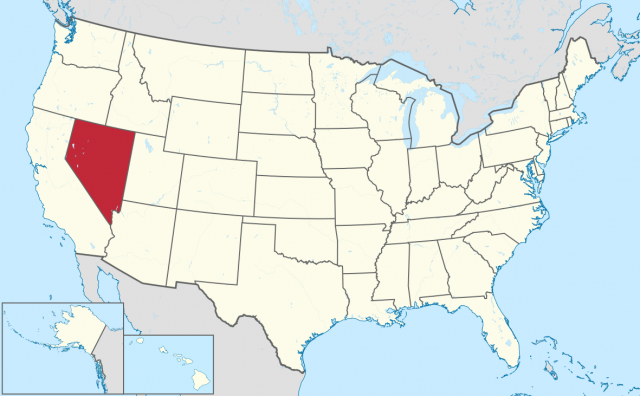The State of Nevada
AT A GLANCE
Name: Nevada means “snowcapped” in Spanish.
Nicknames: Sagebrush State, Silver State
Capital: Carson City
Size: 110,567 sq. mi. (286,367 sq km)
Population: 2,890,845 (2015 est)
Statehood: Nevada became the 36th state on October 31, 1864.
Electoral votes: 5 (2016)
U.S. representatives: 3
State trees: single-leaf pinon and bristlecone pine
State flower: sagebrush
State animal: desert bighorn sheep
Highest point: Boundary Peak, 13,140 ft. (4,005 m)

THE PLACE
Nevada is one of the mountainous states of the West. Most of Nevada is located within a large desert area known as the Great Basin. The northeastern corner of the state is a lava-made plateau full of steep ridges and streams. The land flattens into prairie close to the state's border with Idaho.
The Sierra Nevada is a rugged mountain range that cuts across the south and west of Nevada. Lake Tahoe is the most famous lake in this region. Other smaller mountain ranges cover the rest of Nevada. Grasses grow in many of the valleys between Nevada's mountains, where cattle often graze.
The regions of Nevada all have different weather. The northern and mountainous parts have long, cold winters and hot summers, and winter is milder in the south and west. Since Nevada has poor soil, its most important resources are its varied mineral deposits, which include copper, mercury, gold, silver, and petroleum.
Facts and Firsts
- Nevada has more mountain ranges than any other state.
- Nevada's lakes are home to some unique species of fish, like the cui-ui, a large sucker from Pyramid Lake, and the Devils Hole pupfish from Devils Hole. These fish are found nowhere else in the world because they were isolated in lakes thousands of years ago when prehistoric rivers dried up.
- The U.S. government owns about 80 percent of Nevada's land, the largest percentage of any state.
- Nevada produces more gold than any other state. In the world, it is second only to the country of South Africa.
- Hoover Dam in Nevada was the biggest single public works project in the history of the United States. It contains about 4.5 million cubic yards (3.4 million cu m) of concrete—enough to pave a two-lane highway from San Francisco to New York City.
- In 1999, Nevada had 205,726 slot machines for gambling—one for every 10 state residents.
THE PAST
Nevada has one of the longest and richest Native American histories of any state. Cave paintings from thousands of years ago have been found in this region. The first Europeans arrived in Nevada in the 1770s, when the Spanish claimed it as part of the territory of Mexico. Fur traders from Canada and the eastern United States also made their way to Nevada during the early 1800s.
Nevada became part of the United States at the end of the Mexican-American War in 1848. Soon after, a group of Mormons who sought religious freedom settled in Nevada. They supplied provisions to prospectors who traveled to California in search of gold.
Major settlement in Nevada was slow until the Comstock Lode, a huge deposit of silver, was discovered near Carson City in 1859. The area became a thriving mining center, where life was dangerous, expensive, and often lawless.
Nevada became a state in 1864, during the Civil War. It was admitted to the Union with the support of President Abraham Lincoln, who wanted another free state that would help pass his antislavery proposals.
After the Civil War, the federal government reduced the amount of silver used in its coins, and as a result, many Nevada mines failed. Once-thriving mining towns became ghost towns as people left the state to find work elsewhere. During the next 80 years, prices for mined goods rose and fell unpredictably because of the Great Depression and two world wars. As mining declined, however, cattle ranching became more important.
In 1931, the Nevada legislature made gambling legal in the state. After World War II, tourism began to increase as visitors took advantage of the legal gambling in Las Vegas and Reno and the beautiful scenery around Lake Tahoe, Nevada's most famous resort.
THE PRESENT
Today, Nevada is most famous for Las Vegas and Reno, the sites of huge hotels, nightclubs, and casinos. Nevada has the loosest gambling laws of any state. Each year, more than 40 million tourists spend billions of dollars in Nevada.
Sports, ranches, and fishing resorts also attract many people to Nevada. The service industries around the tourist centers of Las Vegas and Reno contribute about one-third of the entire state's yearly income. More than four-fifths of Nevada residents and many people from other states also live in these metropolitan areas because of the availability of service industry jobs.
Despite the importance of tourism to Nevada's economy, mining remains one of the state's chief industries. Nevada produces almost two-thirds of all the gold mined in the United States and mines more silver than any other state.
Petroleum, gravel, and sand are also valuable products. Many of these minerals are used to support Nevada's manufacturing industries, which process meat; make concrete, computer, and electronic equipment; and publish printed materials. Raising livestock is also a chief economic activity. Most farms operate near the Colorado River, where irrigation enables the growth of crops.
Born in Nevada
- Andre Agassi, tennis player
- Robert Caples, painter
- Abby Dalton, actress
- Michele Greene, actress
- Sarah Winnemucca Hopkins, author and Paiute interpreter
- Thelma “Pat” Nixon, first lady
- Lute Pease, cartoonist and Pulitzer Prize winner